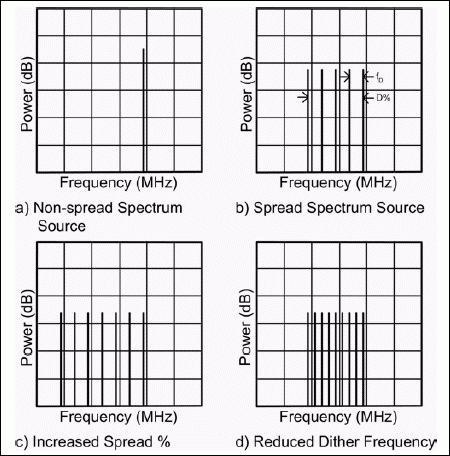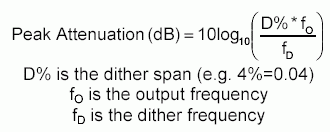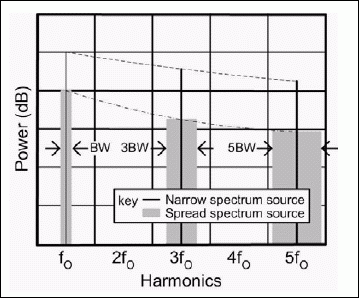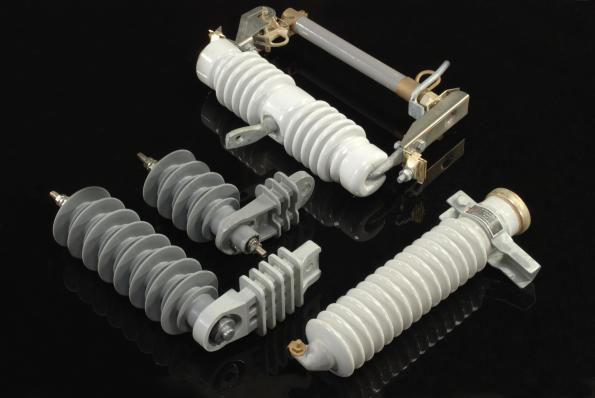Ideally with this architecture the peak power attenuation is always proportional too the dither span and the ratio of the output frequency to the dither frequency. This application note discusses the practical limits for these parameters incurred due to the way power spectrums are measured. The peak power attenuation seen in the power spectrum of a dithered oscillator is derived from the fact that both the dithered and undithered oscillators deliver the same amount of power into a given load. An undithered oscillator (Figure 1a) delivers all the signal power at one frequency. The dithered signal's (Figure 1b) power is delivered via multiple spectral lines with a lower power level for each individual spectral line. Both increasing the dither percentage (Figure 1c) and reducing the dither frequency (Figure 1d) increase the number of spectral lines, which reduces the power of any one spectral line. A formula for calculating the expected peak power attenuation versus a narrow band source is given by: This formula is only accurate when the dither frequency is high enough that there is only one spectral line per measurement bandwidth. This phenomenon is described below and illustrated by Figure 2. The resolution bandwidth used during measurements on spread-spectrum oscillators has a profound effect on the levels measured for two reasons. The first reason is the resolution bandwidth used for a measurement determines what is narrow-band and what is a wide-band signal. If a signal that has a 100Hz bandwidth and its frequency is within the range of a 1kHz bandpass filter, the analyzer can easily detect the power level of the entire signal by taking one measurement. This makes the 100Hz signal narrow band with respect to the analyzer's current settings. If the signal's bandwidth becomes 10kHz while retaining the same power level, the analyzer will read only a portion of the power per measurement because the entire signal cannot be measured within one resolution bandwidth. Thus, the DS1086L dither percentage should be set high enough that the signal being measured is wider than the resolution bandwidth or no EMI improvement will be measured because the signal is perceived as narrow ba nd. The EMI will be attenuated versus the non-dithered signal, but it will not measure as such, which is important when trying to comply with EMC standards. The second relationship between the resolution bandwidth and the dither is that the dither frequency must be greater than the resolution bandwidth if lowering the dither frequency is expected to increase the attenuation. This condition is true because when multiple spectral lines exist within one measurement bandwidth, the power from all the spectral lines within the measurement bandwidth will add to produce the same power as one spectral line within the bandwidth (Figure 2). Thus once the dither frequency is below the resolution bandwidth, there is no longer any attenuation benefit to be gained by further reducing the dither frequency as identified by the attenuation formula. It should be noted that this statement is not intended to imply that the dither frequency should not be lower than the resolution bandwidth. Often, the measurement bandwidths of concern are those required to meet the FCC part 15 class B standard. Part 15 requires that frequencies below 30MHz are detected with a 9kHz measurement bandwidth and frequencies between 30MHz and 1GHz are measured using a 120kHz measurement bandwidth. The dither frequency of the DS1086L is between 4.1kHz and 32.5kHz depending on the dither rate setting and the master oscillator frequency. For measurements above 30MHz, there are always multiple spectral lines per measurements, so there is no obvious benefit to using any particular dither frequency setting . The lower dither frequency settings still have a non obvious benefit that they reduce the slight peaks caused by internal bandwidth limitations that can be seen at the edges of the spread-spectrum bandwidth. For frequencies below 30MHz, the lowering the dither frequency provides more attenuation until the dither frequency is below the 9kHz measurement bandwidth. Spread-spectrum oscillators can see an additional benefit related to measured harmonic content. The bandwidth of the odd harmonics of a frequency modulated square wave is equal to harmonic number times the bandwidth of the square wave at the fundamental frequency (see Figure 3). wider bandwidth is a result of the separation of the spectral lines, which reduces the number of spectral lines per measurement bandwidth. This phenomenon is particularly important when the examining the oscillator using the 120kHz FCC measurement bandwidth. As mentioned before, there are always multiple spectral lines with the DS1086L near the fundamental frequency when using the 120kHz measurement bandwidth, but as the spectral lines separate at the harmonics, the peak power is reduced beyond the 1 / n reduction. The harmonic roll off is approximately 1 / n3 / 2 until the spectral lines separate far enough that there is only one spectral line per measurement bandwidth. The reason that a non-dithered signal, such as a low jitter crystal oscillator, does not benefit from the widening bandwidth phenomenon is that the bandwidth is much narrower than the measurement bandwidth to begin with. When looking at the 3rd or 5th harmonic, the 3x or 5x signal bandwidth is still narrow band compared to the 120kHz measurement bandwidth so all the energy is still being detected within one measurement.
Cut Out Fuse is a combination of a fuse and a switch, it`s voltage is up to 11kv-33kv, which is made of porcelain, polymer or steel. When the current exceed the specified value, Drop Out Fuse ( Polymer Cut Out Fuse and Porcelain Cut Out Fuse ) will produce heat and disconnect. Arrester is made of porcelain or polymer. The voltage is 11kv-33kv. it is a device used on electrical power systems to protect the insulation and conductors of the system from the damaging effects of lightning.
In electrical distribution, a fuse cutout or cut-out fuse is a combination of a fuse and a switch, used in primary overhead feeder lines and taps to protect distribution transformers from current surges and overloads. we make available these fuses in varied specifications to meet the clients' different preferences in an efficient manner.
China Cut Out Fuse,Polymer Cut Out Fuse supplier & manufacturer, offer low price, high quality Drop Out Fuse, 10 Amp Fuse , etc.
We warmly welcome friends both domestic and abroad to visit our company, if you have any questions, please contact with us directly.
Cut Out Fuse,Polymer Cut Out Fuse,Drop Out Fuse,10 Amp Fuse FUZHOU SINGREE IMP.& EXP.CO.,LTD. , https://www.cninsulators.com
IntroductionThe DS1086L is a 3.3V spread-spectrum oscillator that is used in applications concerned about complying with electromagnetic compatibility (EMC) standards such as FCC part 15 or CISPR 22. The output of the DS1086L is a 50% duty cycle square wave that is frequency modulated by a triangle wave to produce a flat wide-band spectrum with lower peak power levels. 
Figure 1. Spectral components of non-dithered and dithered oscillators. 

Figure 2. The ideal dither frequency and the effects of dithering at lower frequencies. 
Figure 3. Spectral content for dithered oscillator harmonics.
Features
1. Reliable operations
2. Rugged construction
3. Longer service life
A lightning arrester is a device used on electrical power systems and tele communications systems to protect the insulation and conductors of the system from the damaging effects of lightning. With these products manufactured as per latest technology standards, these are able to deliver optimum functionality in given application areas.
Features
1.Good hydrophobic nature
2.Superior external insulation property
3.Ozone Resistance
4.Good mechanical performance and anti-ageing
5.Assurring best overall protection for transmission and transformation equipment


Abstract: The DS1086L is a 3.3V spread spectrum oscillator that is used in applicaTIons concerned with complying with electromagneTIc compaTIbility (EMC) standards such as FCC part 15 or CISPR 22.Ideally with this architecture the peak power attenuaTIon is always proportional too the dither span and the ratio of the output frequency to the dither frequency. This application note discusses the practical limits for these parameters incurred due to the way power spectrums are measured.